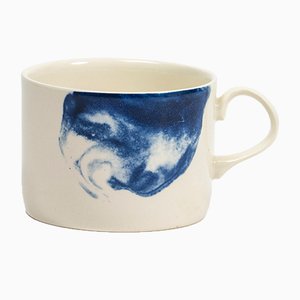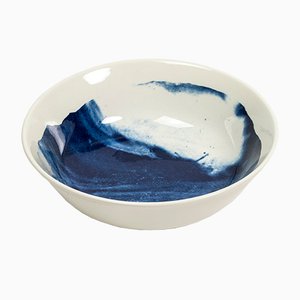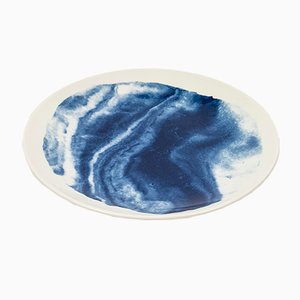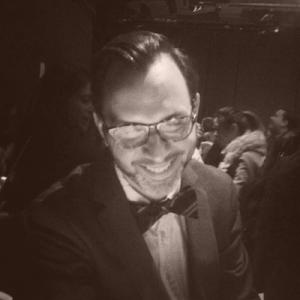JamesPlumb's passion for the past drives their future
Mood Indigo
-
Installation view of Burnished Indigo at The London Design Festival, 2014
Photo © Mari Luz Vidal / Openhouse Magazine; courtesy of JAMESPLUMB
-
Chesterfield Table, 2014
Courtesy of JAMESPLUMB
-
The cut fabric for Burnished Indigo
Courtesy of JAMESPLUMB
-
Fabric washing process for Burnished Indigo
Courtesy of JAMESPLUMB
-
Upholstery process of Chesterfield Table, 2014
Courtesy of JAMESPLUMB
-
Back detail of Chesterfield Table, 2014
Courtesy of JAMESPLUMB
-
Installation view of Burnished Indigo at LDF, 2014
Courtesy of JAMESPLUMB
-
Scrunching fabric for Burnished Indigo
Courtesy of JAMESPLUMB
-
Detail of the fabric for Burnished Indigo
Courtesy of JAMESPLUMB
-
Installation view of Indigo Luminaires at LDF, 2014
Courtesy of JAMESPLUMB
-
Installation view of Indigo Luminaires at LDF, 2014
Photo © Mari Luz Vidal / Openhouse Magazine; courtesy of JAMESPLUMB
-
Detail of the Indigo Luminaires
Courtesy of JAMESPLUMB
-
Detail of the Indigo Luminaires
Courtesy of JAMESPLUMB
-
Detail of the Indigo Luminaires
Courtesy of JAMESPLUMB
-
Production of the brass components for Burnished Indigo
Courtesy of JAMESPLUMB
-
Production of the brass components for Burnished Indigo
Courtesy of JAMESPLUMB
-
Exhibition text for Burnished Indigo at LDF, 2014
Photo © Mari Luz Vidal / Openhouse Magazine; courtesy of JAMESPLUMB
-
Burnishing the exhibition text for Burnished Indigo at LDF, 2014
Courtesy of JAMESPLUMB
-
Installation view of Burnished Indigo at LDF, 2014
Photo © Mari Luz Vidal / Openhouse Magazine; courtesy of JAMESPLUMB
-
Indigo-themed food event at The London Design Festival, 2014
Photo © Mari Luz Vidal / Openhouse Magazine; courtesy of JAMESPLUMB
-
Indigo-themed food event inside Burnished Indigo at LDF, 2014
Photo © Mari Luz Vidal / Openhouse Magazine; courtesy of JAMESPLUMB
-
Indigo-themed food event inside Burnished Indigo at LDF, 2014
Photo © Mari Luz Vidal / Openhouse Magazine; courtesy of JAMESPLUMB
-
Indigo-themed food event inside Burnished Indigo at LDF, 2014
Photo © Mari Luz Vidal / Openhouse Magazine; courtesy of JAMESPLUMB
-
Installation view at LDF, 2014
Photo © Mari Luz Vidal / Openhouse Magazine; courtesy of JAMESPLUMB
-
Installation view at LDF, 2014
Photo © Mari Luz Vidal / Openhouse Magazine; courtesy of JAMESPLUMB
James Russell and Hannah Plumb met at art school through a quirk of fate. “It was mainly down to alphabetical order,” Plumb explains to me via Skype from their sunny London studio. The two of them were in the same foundation class at university and got bracketed together because of their last names. Ever since, their lives and careers have been intertwined, first as friends, then as a couple, and then as partners in JamesPlumb.
While the two trained as fine artists, over the years, they’ve landed rather closer to design, creating lighting, assemblages, and even entire interiors—all inspired by the overlooked, the timeworn, and the historical. The studio’s work fuses unexpected objects together, fashioning new stories out of bygone furnishings with markedly modern interventions. For Cupboard Steps (2013), for example, they joined a Georgian corner cupboard with a fragment of a medieval spiral staircase, elevating the cupboard from a simple storage unit to an extraordinary anomaly. For A Reading Room (2012), the pair transformed a Victorian pulpit (“discovered in a tangled mess of overgrown brambles”) from “a platform for public speech to a cocooned space for quiet contemplation.” There is a stroke of moody romance—as well as a bit of humor—that colors much of JamesPlumb’s work; the result of what the couple describes as a near obsessive approach that allows them to successfully integrate the past with the present.
Plumb smokes throughout our hour or so interview. She’s the intuitive one, following her impulses to their marvelous conclusion. She jumps up throughout our talk, throwing open the door to their back room, crinkling fabric and asking me to listen to the noise it makes, even bending over to pluck their adorable gray dog from the floor to introduce him to me, proudly saying, “This is Wilfred!”
Russell, meanwhile, is delightfully self-deprecating with a curly mop of hair. He's perhaps the more cerebral of the two, a counterpoint to Plumb. However, as they explain, breaking down who does what in JamesPlumb can be complicated. “We often joke, Oh, that was my idea. No, actually, it was mine,” says Plumb. “Everything gets pushed and pulled between us a lot.”
The shared history and day-to-day realities of living and working together afford the couple quite a bit of shorthand. “There aren’t many things we don’t do together,” Russell notes, “which means that we are very in tune. It allows us to develop ideas quite fast and instinctively. We immediately see where the other one is going with an idea; we don’t need to over explain.”
Back in 2009, after years of collaboration, Russell and Plumb debuted JamesPlumb at the Tent London design fair. Leading up to the event, the two were quite nervous; not only because this was their first design fair as a studio, but also because, as a firm that aims to create a “full experience” when presenting work, they were anxious about the atmospheric limitations of a design fair booth.
“We really tried to do it in our way, so we’d be comfortable,” Russell adds. “We wanted to do more than simply place our work on plinths; we wanted to create a whole interior and exterior experience for our visitors.” To that end, the pair produced a giant black tent and interior, modeled on the surprisingly luxe officer tents of travelling armies of centuries past. Visitors were invited to mill around inside and talk with Russell and Plumb while looking at the pieces with which they’d furnished the space—furniture and assemblages, including early examples from their Monuments to the Anonymous series, such as the Charles Munn lamp fashioned from a Lancaster bomber instrument light and a Victorian roller skate, and the Mrs. Fletcher assemblage composed of an old overhead projector, a lace lampshade, and mismatched porcelain dolls legs that produced the enchanting image of a dancer.
“I think a lot of people were caught by surprise. At the end of these endless rows of booths—with a lot of other very interesting work—there was this great big, black tent,” explains Russell. “It really was like a miniature version of our home at the time.”
“We wanted to bring our oven,” Plumb adds, smiling, "but we weren’t allowed."
As their practice has grown, they’ve continued to make bold, often surprising objects and spaces that “explore the gray areas between art and design.” And JamesPlumb still finds inspiration in relics from the past. Their most recent project, the limited-edition Burnished Indigo collection, is a perfect example of the studio’s knack for highly sculptural, modern twists on the historical. The lighting and furniture series originated with a 19th-century chesterfield sofa the pair found at an antiques fair. It was absolutely destroyed—the seat was completely gone—but they fell in love with it.
The pair was particularly drawn to the sofa’s worn but sumptuous leather upholstery. The leather was “like paper,” says Plumb. Initially, they tried to duplicate it in-house, attempting, over the course of two years, different combinations of processes on different fabrics to achieve the delicious patina of that original piece. None of their carefully researched efforts, however, produced just the effect they were looking for.(“We often came close,” Plumb recalls, “but we didn’t want to compromise.” They began to question the wisdom of trying to ape something so distinctive.
Things seemed to be stuck until a friend introduced them to a romantic, out-of-time character: a man who trades antique fabrics from around the world. Working through him, they were able to procure existing, genuine pieces of burnished indigo—some more than half a century old. The fabrics had been produced in complicated rituals by tribes in rural China, whose techniques involved first coloring the fabric by repeatedly submerging it in deep blue indigo, and then fixing it with various other elements. “Different tribes—all within the same area—all have subtly different ways of doing it,” explains Russell. Some of them will dip it into pigs’ blood, some of them in ox blood, and some will wash fermented fruit juices over it at a certain stage.” The fabric is then burnished, placed beneath large smoothing stones or beaten with wooden mallets to increase its overall sheen.
JamesPlumb used this fabric to cover the collection’s Chesterfield Table, a theatrical yet classic chesterfield sofa silhouette that is interrupted mid-seat by a long, beautiful wood table—also vintage, and crafted from antique church pews. “By scrunching and working with the fabric in a certain way,” Russell says, “it took us right back to that feeling of that sofa: the same aura, the same excitement.”
The Burnished Indigo collection also includes a series of four wall-mounted lamps called Indigo Luminaires. Perhaps a purer celebration of the fabric itself, for each lamp JamesPlumb transformed existing, pleated ceremonial skirts into rippling, wave-like lampshades.
“What was such a stiff, seemingly uncompromising fabric suddenly had this amazing fluidity,” explains Russell. “We really do our best to be faithful to the original sewing, the incredibly fine and time-consuming stitching the tribes do themselves. We thought, surely there will be a formula for the small ones: we can make a ring this big . . . But each and every one has to be custom made, down to the millimeter, for each particular fragment of fabric we’re working with. Each one behaves differently.”
The pieces are full of intriguing contradictions: cold and warm, staid and revolutionary, formal and wildly original. But, then, that’s typical of JamesPlumb. “If we’d studied, say, furniture design, would it feel more restrained?” muses Russell. “It’s certainly not conscious. We don’t try to be different just for the sake of it, but I think we do consciously bring in a very artistic approach, even if we’re making a lamp. This, of course, removes us from the mainstream, but we are at home out here. And clients who share our point of view find a path to our door."
-
Text by
-
Chris Chafin
Chris is a Brooklyn-based writer who's contributed to publications like Rolling Stone, Wired, Fast Company, and The Awl. He'd be flattered if you'd consider following him on Twitter
-
Designbegeisterte hier entlang
Indigo Storm Pasta Schale von Faye Toogood für 1882 Ltd

Indigo Storm Tasse von Faye Toogood für 1882 Ltd

Indigo Storm Tasse ohne Griff von Faye Toogood für 1882 Ltd

Indigo Storm Schale von Faye Toogood

Indigo Storm Salatteller von Faye Toogood

Indigo Storm Teller von Faye Toogood für 1882 Ltd

Mbake Kissen in Indigoblau von Nzuri Textiles



























 James Russell and Hannah Plumb of JAMESPLUMB
Courtesy of JAMESPLUMB; Photo © Mari Luz Vidal / Openhouse Magazine
James Russell and Hannah Plumb of JAMESPLUMB
Courtesy of JAMESPLUMB; Photo © Mari Luz Vidal / Openhouse Magazine
